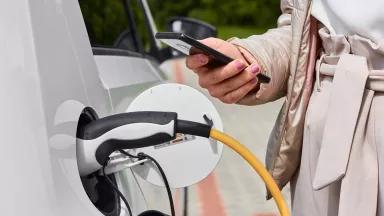Electric vs. Gas Cars: Is It Cheaper to Drive an EV?
Chances are, yes. Here’s how to be sure.

There are plenty of climate and air quality reasons to buy an electric vehicle (EV), but is it cheaper to drive? While this is a complicated question that has befuddled car shoppers for years, in most cases, an EV will indeed be cheaper in the long run. And with automakers slashing prices for EVs in the past year on top of federal incentives for eligible buyers, you may even be able to score a bargain up front. Let’s sort out the details.
Sticker prices for electric vs. gas cars
According to data from Cox Automotive (parent company of Kelley Blue Book), the average price paid for a new EV has fallen significantly—in September 2023, it came down by $14,300 over the prior year. This amounted to a cost of just $2,800 more than the average paid for a new gas-powered vehicle. And with the EV market growing rapidly, the price margin is expected to shrink even more in the coming years as manufacturers produce more affordable models and improve battery technology, the most expensive part of an EV.
You can mitigate some of that cost by making use of tax incentives, which can shave thousands off an EV’s price tag. The federal EV tax credit offers up to $7,500 for new EVs and, for the first time, $4,000 for used EVs, too, for eligible buyers and EVs. In addition, new rules from U.S. Department of the Treasury will soon allow participating auto dealers to provide the tax credit directly to consumers at the point of sale, making savings more immediate. One asterisk: Automakers must now meet new EV manufacturing requirements in order for their vehicles to qualify for those federal incentives, which will likely temporarily impact the availability of eligible EVs while supply chains catch up. Many states offer their own tax incentives, too, so take the time to search for what’s available for the model you’re interested in buying.
Be sure to also consider adding an EV charger to your home. Charging from a standard 120-volt outlet for eight hours overnight will add about 32 miles of range, which is typically plenty for daily driving needs. If you want to charge faster to be able to make frequent and/or longer trips, installing a Level 2, 240-volt outlet and charger in your garage can allow you to add more than 250 miles overnight. That installation will typically cost you about $2,000, but some states and local utility companies offer incentives to offset it, as does the Inflation Reduction Act.
Once you have an idea of what incentives you qualify for, you should be able to better compare car prices.
Cost of electricity vs. gasoline
Here’s where EV owners win out. Going electric means you get to skip pricey trips to the pump, which is one of the biggest draws for making the switch. A 2018 study by the University of Michigan’s Transportation Research Institute found that the average cost to fuel an electric car was $485 a year, compared to $1,117 for a gas-powered vehicle. A 2020 Consumer Reports study similarly showed that EV drivers tend to spend about 60 percent less each year on fuel costs compared to drivers of gas-powered cars. And in 2023, the nonpartisan policy firm Energy Innovation released a report showing that these savings benefit drivers across the United States: Every EV model in every state is cheaper to fill than a gas-powered vehicle. These savings are largely based on the fact that current EVs are 2.6 to 4.8 times more efficient at traveling a mile compared to a gasoline internal combustion engine, according to real world data collected by the U.S. Department of Energy (DOE).
But these savings calculations aren’t the same for everyone. Here’s where it can get a little complicated.
For starters, EVs can vary in efficiency—that is, how far they can go on the same amount of electricity. For an EV, efficiency is measured by how many kilowatt-hours (kWh) of electricity it consumes per 100 miles—similar to a gas-powered car’s miles-per-gallon stat. (A lower kWh/100 miles rate is better.) The 2023 Hyundai Ioniq 6 is a standout in terms of efficiency, with 24 kWh/100 miles, but the more budget-friendly 2023 Chevrolet Bolt EUV is comparable, with a 29 kWh/100 miles rating. So make sure to consider this factor when comparison shopping.
Charging your car at home will cause your electricity bill to rise, but by how much will depend on factors like when you charge it and where you live. Electricity costs, like gas prices, can vary significantly by region. Many electric utilities offer lower electricity rates for charging during off-peak hours versus peak, so you'll want to take advantage of this when charging your EV, and many EVs can be programmed to automatically charge during those hours when rates are low. Taking these charging costs into account, a 2020 study broke down the lifetime fuel costs of battery-powered EVs versus internal combustion engine cars state by state. EV owners in Washington State, for example, can save as much as $14,480 over the life of their vehicle—the highest margin in the country. On the other end of the spectrum is Hawaii, where going electric could ultimately cost $2,494 more over 15 years.
To get a rough estimate of your own charging costs, multiply an EV’s kilowatt-hour (kWh/100) mileage rate by your electricity rate (measured in cents per kWh), which you can find on your monthly bill. This will give you the electricity costs per 100 miles driven. After figuring in the number of miles you typically drive in a month, you’ll be able to see how much your electric bill may go up. Keep in mind that charging your car overnight, when electricity demand and prices drop, can save you 30 percent on that charge.
Also note that public charging stations tend to be more expensive than charging at home. If you rely exclusively on these stations—which do offer faster, higher-voltage charging—your fueling costs could significantly increase.
After you figure out how these factors apply to you and your preferred EV model, compare your final electricity cost estimate to what you typically spend on gas.
Maintenance costs for electric vs. gas cars
Without spark plugs to replace or oil to change, electric vehicles have a clear leg up on maintenance costs. EVs also have the unique feature of “regenerative” braking—recovering the energy normally lost to braking—which saves on brake pad replacements. Electric cars do still require some basic maintenance, of course, like service checks and tire rotations. But in general, electric vehicles typically cost half as much to maintain and repair as gas-powered cars.
Lifetime costs for electric vs. gas cars
Now, to calculate that all-important number: whether an electric car will be cheaper over the life of the vehicle.
You can figure out your savings estimate by adding together the up-front costs of your specific model (minus tax rebates) and then ongoing costs. (The DOE has created a calculator to help with this task.) You’ll need to account for your model’s efficiency, how much you plan to drive, regional electricity costs, charging habits, and maintenance costs per year. Then compare those to the gas-powered alternative. Note that the average amount of time that a driver keeps a new vehicle is seven years, the metric that authors of a 2024 study from Atlas Public Policy, conducted on behalf of NRDC, used when investigating how expenses would stack up for owners of gas cars versus EVs. Weighing the total cost of ownership for five of the most popular internal combustion models across different vehicle classes (i.e., a compact sedan up to a pickup truck) and comparing each to a similarly sized electric version of the same type, the study found that owning an EV would always be cheaper. On the high end, net savings ranged from $7,000 to $11,000.
Another popular model to consider when shopping for a green and budget-friendly car is a plug-in hybrid. These vehicles operate partly on gasoline and partly on electricity from the grid. A plug-in hybrid with an all-electric range of 50 miles could enable you to drive mainly on electricity.
Bottom line: You can bank on saving across the life of your electric vehicle. That’s not too shabby, considering you’ll also be sparing the climate thousands of pounds of carbon pollution over the car’s lifetime, along with other pollutants that create smog, lower local air quality, and cause harm to public health. And of course, carbon pollution carries a price tag of its own (a recent U.S. Environmental Protection Agency analysis pegs the social cost of greenhouse gases at $190 per ton), so when we take measures to rein in emissions, there are concrete savings that go well beyond our own pocketbooks too.
This NRDC.org story is available for online republication by news media outlets or nonprofits under these conditions: The writer(s) must be credited with a byline; you must note prominently that the story was originally published by NRDC.org and link to the original; the story cannot be edited (beyond simple things such as grammar); you can’t resell the story in any form or grant republishing rights to other outlets; you can’t republish our material wholesale or automatically—you need to select stories individually; you can’t republish the photos or graphics on our site without specific permission; you should drop us a note to let us know when you’ve used one of our stories.





How You Can Stop Global Warming
A Consumer Guide to the Inflation Reduction Act
How to Ditch the Biggest Fossil Fuel Offenders in Your Life
How You Can Stop Global Warming
A Consumer Guide to the Inflation Reduction Act
How to Ditch the Biggest Fossil Fuel Offenders in Your Life
How You Can Stop Global Warming
A Consumer Guide to the Inflation Reduction Act
How to Ditch the Biggest Fossil Fuel Offenders in Your Life
How You Can Stop Global Warming
A Consumer Guide to the Inflation Reduction Act